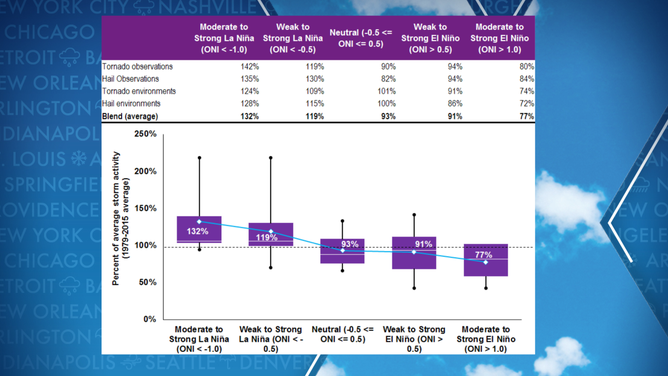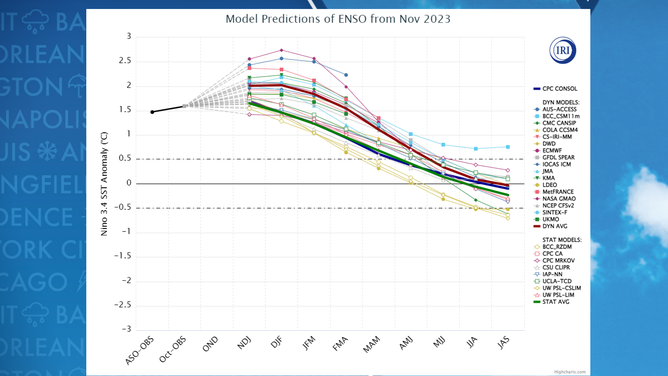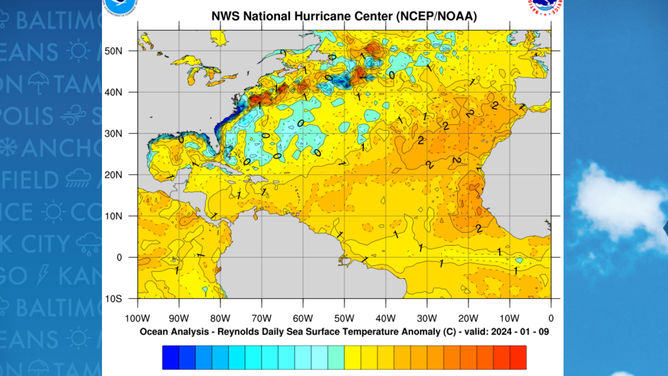7 weather stories to watch in 2024
An El Nino weather pattern that has dominated headlines since June appears to have peaked and will decline in strength throughout the spring. Climate patterns over the Pacific have significant implications on the weather in the U.S. and around the globe. The patterns help dictate if the country sees an active severe weather season, hurricane season and where droughts establish themselves.
El Nino is expected to weaken throughout 2024
Climate experts are now focused on when an El Nino could weaken, leading to climate changes around the globe.
The new year is underway, and if climatology tells us anything about the future, 2024 will be full of extreme weather from coast to coast and around the globe.
Annually, the U.S. experiences significant droughts, flooding, severe weather, hurricanes, droughts, fires and heat waves.
On occasion, these events can reach extreme levels and become billion-dollar disasters. In 2023, NOAA reported an unprecedented number of these extreme weather events- 28 in total, producing nearly $100 billion.
The FOX Forecast Center will track all the events to help protect you and your family. Here’s a preview of weather events to be on the lookout for in 2024.
1) Will winter be a season to remember or a no-show?
Most of the first half of meteorological winter was full of record-warm temperatures and historic snowfall deficits across the country. The lack of any winter is reminiscent of just last year when many communities east of the Mississippi River reported their least snowiest season on record.
The 2022-23 winter was controlled by a La Niña weather pattern, which ended in March. This winter’s influence is dominated by an El Niño, which is on the opposite spectrum than a La Niña event.
Typically, strong El Niño patterns produce warm winters for the U.S., with a lack of snowfall in the northern tier of the country.
A weakening El Niño event, in combination with fluctuations of pressure patterns, can leave the country vulnerable to weather extremes.
Right now, NOAA forecasters believe that when February ends, the country will be able to look back at the winter and say, 'That wasn’t as bad as it could have been.’
But with blizzards on the horizon, it's anyone’s guess how severe the winter will end up.
WHEN CAN YOU EXPECT THE LAST SNOW OF THE SEASON?
2) How active will spring severe weather season be?
A typical year produces around 1,300 tornadoes, 7,500 reports of hail and 14,000 instances of damaging wind gusts.
Both 2022 and 2023 produced around an average amount of tornadoes, but hail and damaging winds were more active than typical.
With El Niño’s grip still over weather patterns, forecasters would expect numbers to trend lower in 2024 when compared to average seasons.
Forecasters believe atmospheric ingredients typically aren’t as conducive during a neutral event than during a La Niña period but are more active than under an El Niño regime.
Research completed by various private, government and educational entities has found that neutral-ENSO conditions tend to produce tornado and hail events that align with average or slightly below-average historical tallies.
Meteorological spring, which consists of the months of March, April and May, is typically the busiest period for severe weather as the jet stream allows plenty of warm moisture to stream northward and aid in the instability needed for thunderstorms.

Hail and tornado activity versus state of atmosphere
(Willis Re/Columbia University / FOX Weather)
WHY TORNADO ALLEY IS SHIFTING EAST
3) When will the El Niño end?
The climate pattern, which has controlled global weather since June, appears to be on the verge of a quick deterioration and is forecast to end in 2024.
When sea surface temperature anomalies in parts of the Pacific drop to a temperature of 0.5 degrees Celsius (0.9 degrees Fahrenheit) or below, a neutral event of the El Niño-Southern Oscillation will be underway.
Many climate models show the average water temperature in critical areas of the Pacific dropping below the needed threshold during the spring, which would lead to the eventual change in weather patterns.

El Nino computer model outlook
(The Columbia Climate School, Columbia University / FOX Weather)
But when the pattern changes will be critical in helping to determine when the country could see a variation in weather.
A pattern that flips during the late spring or summer would miss the heart of the severe weather season but catch the hurricane season to show its effects. A pattern change in September or beyond would miss out on impacting the 2024 hurricane season but would be in place for next winter.
EL NINO APPEARS TO BE ON VERGE OF RAPID COLLAPSE
4) Will North America’s fire season lead to smoke-filled skies?
No year comes close to the number of acres destroyed across Canada and the U.S. than 2023 when more than 48,000,000 acres were consumed by wildfires.
Both countries experience significant wildfires every year, and due to the jet stream placement, smoke is carried either across the country or into the country, depending on the season.
Unfortunately, many areas that experienced significant fires in central and western Canada in 2023 have not received beneficial precipitation, meaning the regions remain in a significant drought.
If ground moisture does not improve, this sets the country up for higher wildfire risks in 2024.
Environment and Climate Change Canada outlooks point to a continued lack of snowfall with above-average temperatures through much of 2024.

North America Drought Monitor
(National Drought Mitigation Center / FOX Weather)
SWELTERING SUMMER NIGHTS REDUCE CHANCES OF COOLING OFF DURING THE DAY
5) Is another summer scorcher ahead?
Forecasters in both Europe and the U.S. believe 2024 will be the hottest year on record, and the months of June, July, and August will play an important role in the year’s global temperature trend.
The previous summer in the U.S. was the 15th warmest on record, with the hottest summer occurring in 2021.
To become the record leader, anomalies this season would have to average greater than 2.60 °F above normal.
Both long-term climate models and the status of the ENSO point towards 2024 having a warmer summer than is typical, but the jury is still out if the year could be in the running to replace 2021’s record.

Temperature anomaly forecast animation
(Tropicaltidbits.com / FOX Weather)
The heat will likely lead to many heat waves and illnesses associated with such extreme events.
The Centers for Disease Control and Prevention reports that, on average, more than 700 heat-related deaths occur every year in the United States.
2023 HURRICANE SEASON: LEAST IMPACTFUL FOR US IN NEARLY A DECADE
6) Will it be another active hurricane season?
The 2023 hurricane season was the least impactful for the Southeast in about a decade, but the Atlantic basin produced 20 named storms.
Unlike 2023, when tropical cyclones were forced to compete with a ramping up El Niño, the 2024 season looks like it’ll have to contend with atmospheric conditions that’ll be the opposite, with an El Niño that is in collapse.
Nearly every climate model depicts a rapidly decaying El Niño event as the heart of the 2024 hurricane season approaches, which could significantly impact tropical cyclone activity in the Atlantic basin.
Many seasons following an El Niño have been busy, with above-average production of tropical storms and hurricanes in the Atlantic basin.
The combination of improving atmospheric conditions for tropical cyclone development in the Atlantic and warm water temperatures throughout the basin argue for a basin that’ll once again beat the typical 14 named storms and seven hurricanes.

Atlantic sea surface temperature anomalies
(NOAA)
2023 FINISHES AS WARMEST YEAR ON RECORD
7) Can 2024 beat 2023’s record global warmth
After the twelfth month concludes, scientists will be able to tell whether 2024 beat 2023’s record heat.
Britain’s national weather service, the Met Office, expects 2024’s global temperature to finish between 1.34 °C and 1.58 °C above average.
If the long-range outlook is accurate, it could beat 2023’s record, which currently sits at around 1.48 °C, according to the European Union's Copernicus Climate Change Service.
Climate experts have long warned that if global temperature anomalies greatly exceed 1.5 °C, irreversible damage could be done to the planet.
"The extremes we have observed over the last few months provide a dramatic testimony of how far we now are from the climate in which our civilization developed. This has profound consequences for the Paris Agreement and all human endeavors. If we want to manage our climate risk portfolio successfully, we need to urgently decarbonize our economy whilst using climate data and knowledge to prepare for the future," Carlo Buontempo, director of the Copernicus Climate Change Service, said in a statement.

Surface air temperature anomaly for 2023
(C3S/ECMWF / FOX Weather)
